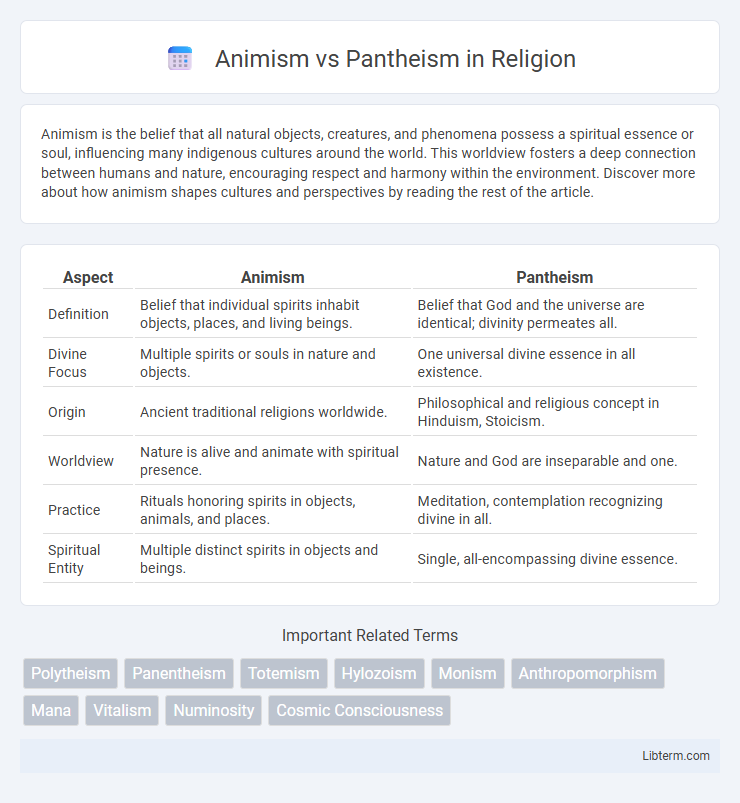Animism is the belief that all natural objects, creatures, and phenomena possess a spiritual essence or soul, influencing many indigenous cultures around the world. This worldview fosters a deep connection between humans and nature, encouraging respect and harmony within the environment. Discover more about how animism shapes cultures and perspectives by reading the rest of the article.
Table of Comparison
| Aspect | Animism | Pantheism |
|---|---|---|
| Definition | Belief that individual spirits inhabit objects, places, and living beings. | Belief that God and the universe are identical; divinity permeates all. |
| Divine Focus | Multiple spirits or souls in nature and objects. | One universal divine essence in all existence. |
| Origin | Ancient traditional religions worldwide. | Philosophical and religious concept in Hinduism, Stoicism. |
| Worldview | Nature is alive and animate with spiritual presence. | Nature and God are inseparable and one. |
| Practice | Rituals honoring spirits in objects, animals, and places. | Meditation, contemplation recognizing divine in all. |
| Spiritual Entity | Multiple distinct spirits in objects and beings. | Single, all-encompassing divine essence. |
Understanding Animism: Core Beliefs and Practices
Animism centers on the belief that all natural entities--including animals, plants, rocks, and rivers--possess a distinct spiritual essence, influencing human life and the environment. Core practices involve rituals, offerings, and communication with these spirits to maintain harmony and seek guidance. This worldview emphasizes interconnectedness and respect for the living and non-living elements of nature, differing from Pantheism's concept of an all-encompassing divine presence within the universe.
Defining Pantheism: Key Concepts and Principles
Pantheism is a worldview that equates the universe and God, asserting that everything collectively forms a divine presence, emphasizing unity between the cosmos and spirituality. Central principles include immanence, the belief that divinity pervades all aspects of existence, and the rejection of a personal, anthropomorphic deity in favor of an all-encompassing, non-personal force. This contrasts with animism, where individual spirits inhabit natural entities, whereas pantheism views divinity as the totality of all matter and energy in the universe.
Historical Origins: Animism and Pantheism in Ancient Cultures
Animism and pantheism both originated in ancient cultures as foundational spiritual beliefs explaining the natural world. Animism, prevalent in early hunter-gatherer societies such as those in Africa and Australia, posited that individual spirits inhabit animals, plants, and inanimate objects. Pantheism emerged in early civilizations like Ancient India and Greece, promoting the idea that the universe and divinity are identical, influencing philosophical traditions such as Vedanta and Stoicism.
Cosmology: How Animism and Pantheism View the Universe
Animism perceives the universe as a collection of individual spirits inhabiting natural objects and phenomena, emphasizing a personal and interconnected cosmos where every element has its own consciousness or life force. Pantheism, by contrast, views the universe as a unified, divine whole, identifying God with the cosmos itself and seeing all matter and energy as manifestations of a single divine essence. Both cosmologies highlight interconnectedness but differ in personifying natural elements versus embracing an all-encompassing divine unity.
The Divine in Nature: Nature Spirits vs. All-Encompassing God
Animism centers on the belief in distinct nature spirits inhabiting trees, rivers, and animals, each possessing a unique consciousness and divine presence. Pantheism identifies the divine with the entire universe, viewing nature and all existence as manifestations of an all-encompassing God or ultimate reality. These differing perspectives influence spiritual practices, with animism fostering reverence toward individual natural entities, while pantheism emphasizes unity with the whole cosmos as sacred.
Spiritual Practice: Rituals in Animism and Pantheism
Rituals in animism often involve communication with spirits through offerings, dances, and ceremonies designed to honor ancestral and natural entities, emphasizing personal relationships with individual spirits. Pantheistic spiritual practices focus on rituals that celebrate the divine presence in all aspects of the universe, such as meditation, nature worship, and seasonal festivals that reinforce the unity of all existence. Both traditions use rituals to connect practitioners deeply with the spiritual world, but animism centers on distinct spirit beings while pantheism embraces a holistic divine essence.
Presence in Modern Spirituality
Animism, recognizing spiritual essence in individual objects and beings, permeates modern indigenous and ecological spiritual practices emphasizing interconnectedness and respect for nature. Pantheism, equating divinity with the universe and its laws, inspires contemporary holistic and environmental movements that view the cosmos as a unified sacred entity. Both belief systems influence mindfulness, eco-spirituality, and New Age philosophies by fostering a profound sense of presence and unity with the natural world.
Similarities and Overlapping Themes
Animism and Pantheism both emphasize a spiritual connection to nature, attributing sacred qualities to natural elements like trees, rivers, and animals. Each tradition recognizes a pervasive, life-giving force that animates all parts of the environment, fostering a holistic worldview where humans and nature are deeply interconnected. Both belief systems encourage respect and reverence for the natural world, promoting ethical interactions with ecosystems and living beings.
Key Differences in Worldview and Theology
Animism posits that individual spirits inhabit natural objects, emphasizing a multiplicity of distinct spiritual beings within nature. Pantheism identifies God with the universe as a whole, asserting an all-encompassing divine presence without distinct spirits. Theologically, animism supports a personalized interaction with spirits, while pantheism promotes a unified, impersonal divine essence inherent in all existence.
Animism and Pantheism in Contemporary Thought
Animism in contemporary thought emphasizes the belief that all entities, including animals, plants, and inanimate objects, possess a distinct spiritual essence, fostering a deep ecological awareness and relational ethics. Pantheism identifies the divine with the universe itself, promoting an understanding of God as immanent in nature and all existence, which influences environmental philosophy and holistic spirituality. Both perspectives challenge anthropocentrism and encourage interconnectedness with the natural world in modern philosophical and religious discourse.
Animism Infographic

 libterm.com
libterm.com